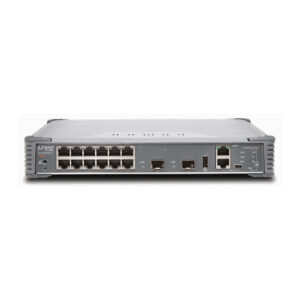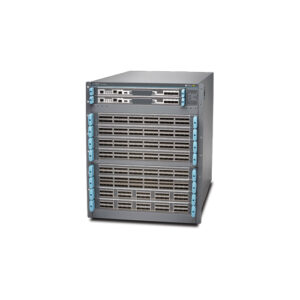Description
EX4100-F Ethernet Switch
Designed for branch deployments, the EX4100-F Ethernet Switches delivers a high-performance, cost-effective solution. With a -12 port fan-less compact, -24 port and -48 port in 1U, the EX4100-F is AI-driven, cloud-ready access switching platform. It’s differentiated by features such as EVPN-VXLAN, micro-segmentation using group-based policies (GBP), Power over Ethernet (PoE+) and flow-based telemetry.
Additionally, EX4100-F-12P (compact and fan-less) can be powered by an external Power Sourcing Equipment (PSE) as well as provide Power over Ethernet out to connected Powered Devices (PDs).
As part of the underlying infrastructure for Juniper Mist™ Wired Assurance, the EX4100-F is easy to onboard, configure, and manage. The Juniper Mist Cloud streamlines deploying and managing your campus fabric, while Mist AI™ simplifies operations and improves visibility into the performance of connected devices.
EX4100-F models:
EX4100-F-12P/T: 12 x 1GbE PoE/Non-PoE, 2 x 100M/1/2.5/5/10 GbE uplinks, and 4 x 10GbE stacking/uplinks
EX4100-F-24P/T: 24 x 1GbE PoE/Non-PoE, 4 x 1/10GbE uplinks, and 4 x 10GbE stacking/uplinks
EX4100-F-48P/T: 48 x 1GbE PoE/Non-PoE, 4 x 1/10GbE uplinks, and 4 x 10GbE stacking/uplinks
Key Features
Port density : 1GbE access ports, 1/10 GbE uplink/stacking, 100M/1/2.5/5/10 GbE uplink
Form factor : 1 RU
Power : PoE+ up to 30W per port, 180W* PoE for EX4100-F-12P, 370W PoE for EX4100-F-24P, and 740W PoE for EX4100-F-48P
* 180W PoE budget with AC adapter and up to 300W PoE budget with AC adapter and Uplink PD Ports.
Switching capacity : 256 Gbps
Fabric : EVPN-VXLAN, Virtual Chassis
Features + Benefits
AI-Driven Switching
Onboard (day 0), provision (day 1), and manage (day 2+) the EX4100-F from the cloud with Juniper Mist Wired Assurance, using AI-driven automation and insights to deliver improved experiences for IT staff, end users, and connected devices.
Streamline IT operations, reduce mean time to repair, and deliver a new generation of wired and wireless networks. The EX4100-F provides rich streaming telemetry data for insights into switch health and wired service-level expectations (SLEs) for pre- and post-connection metrics.
Microsegmentation
Standards-based microsegmentation using group-based policies (GBP) leverages underlying VXLAN technology to provide agnostic endpoint access control for consistent security policies and granular control of application, business function, or user tags.
Take segmentation to the next level by separating traffic within the same VLAN so IoT devices or users can traverse any port or switch within the network; maintain the same security policies without having to manually configure them each time.
Flow-Based Telemetry
Enables per-flow level analytics, so you can monitor thousands of traffic flows per switch without impacting the CPU.
For example, in the case of a DDoS attack, when flow thresholds are breached, the attack can be quickly detected. You can implement automated workflows to triage problems, such as quarantining a port or examining the traffic.
PoE, PoE+, and Fast and Perpetual PoE
The EX4100-F offers fast and perpetual PoE that enables consistent power to be provided to the endpoints, even when the switch is rebooting. The switch also support a fast PoE capability that delivers PoE power to connected endpoints during a switch power-up, even before the switch is fully operational.
Precision Time Protocol Clock Built In (PTP)
EX4100-F switches support Precision Time Protocol (PTP), also known as IEEE 1588v2.
This is a packet-based technology that enables the operator to deliver synchronization services on packet-based mobile backhaul networks. The IEEE 1588 PTP (Version 2) clock synchronization standard is a highly precise protocol for time synchronization that synchronizes clocks in a distributed system. The time synchronization is achieved through packets transmitted and received in a session between a primary clock and a client clock.
EVPN-VXLAN Technology
Most traditional campus networks have a single-vendor, chassis-based architecture that worked well for smaller, static campuses with few endpoints. However, this approach is too rigid to support the changing needs of modern campus networks. The EX4100-F supports EVPN-VXLAN, extending an end-to-end fabric from campus core to distribution to the access layer.
An EVPN-VXLAN fabric is a simple, programmable, highly scalable architecture built on open standards. This technology can be applied in both data centers and campuses for architectural consistency. A campus EVPN-VXLAN architecture uses a Layer 3 IP-based underlay network and an EVPN-VXLAN overlay network. A flexible overlay network based on a VXLAN overlay with an EVPN control plane efficiently provides Layer 2 and/or Layer 3 connectivity throughout the network. EVPN-VXLAN also offers a scalable way to build and interconnect multiple campus sites, delivering:
Virtual Chassis Technology
Juniper’s Virtual Chassis technology allows multiple interconnected switches to operate as a single, logical unit, enabling users to manage all platforms as one virtual device. Up to 10 EX4100-F switches can be interconnected as a Virtual Chassis using 4 x 10GbE SFP+ dedicated front-panel ports. Although configured as Virtual Chassis ports by default, the 4 x 10GbE SFP+ ports can also be configured as uplink ports. The EX4100-F switches can form a Virtual Chassis with any other models within the EX4100-F product line.
Microsegmentation Using Group-Based Policy
GBP leverages underlying VXLAN technology to provide location-agnostic endpoint access control. This allows network administrators to implement consistent security policies across the enterprise network domains. The EX4100-F supports a standards-based GBP solution, allowing different levels of access control for endpoints and applications even within the same VLAN. Customers can simplify their network configuration by using GBP, avoiding the need to configure large numbers of firewall filters on all their switches. GBP can block lateral threats by ensuring consistent application of security group policies throughout the network, regardless of the location of endpoints and/or users.
Flow-Based Telemetry
Flow-based telemetry enables flow-level analytics, allowing network administrators to monitor thousands of traffic flows on the EX4100-F without burdening the CPU. This improves network security by monitoring, baselining, and detecting flow anomalies. For example, if predefined flow thresholds are breached due to an attack, IP Flow Information Export (IPFIX) alerts can be sent to an external server to quickly identify the attack. Network administrators can also automate specific workflows, such as further examining the traffic or quarantining a port, to triage the issue. In addition to DOS attacks, Flow-Based Telemetry on EX4100-F can measure packet delays at ingress, chip, and egress points as well as report drop reasons.









Reviews
There are no reviews yet.